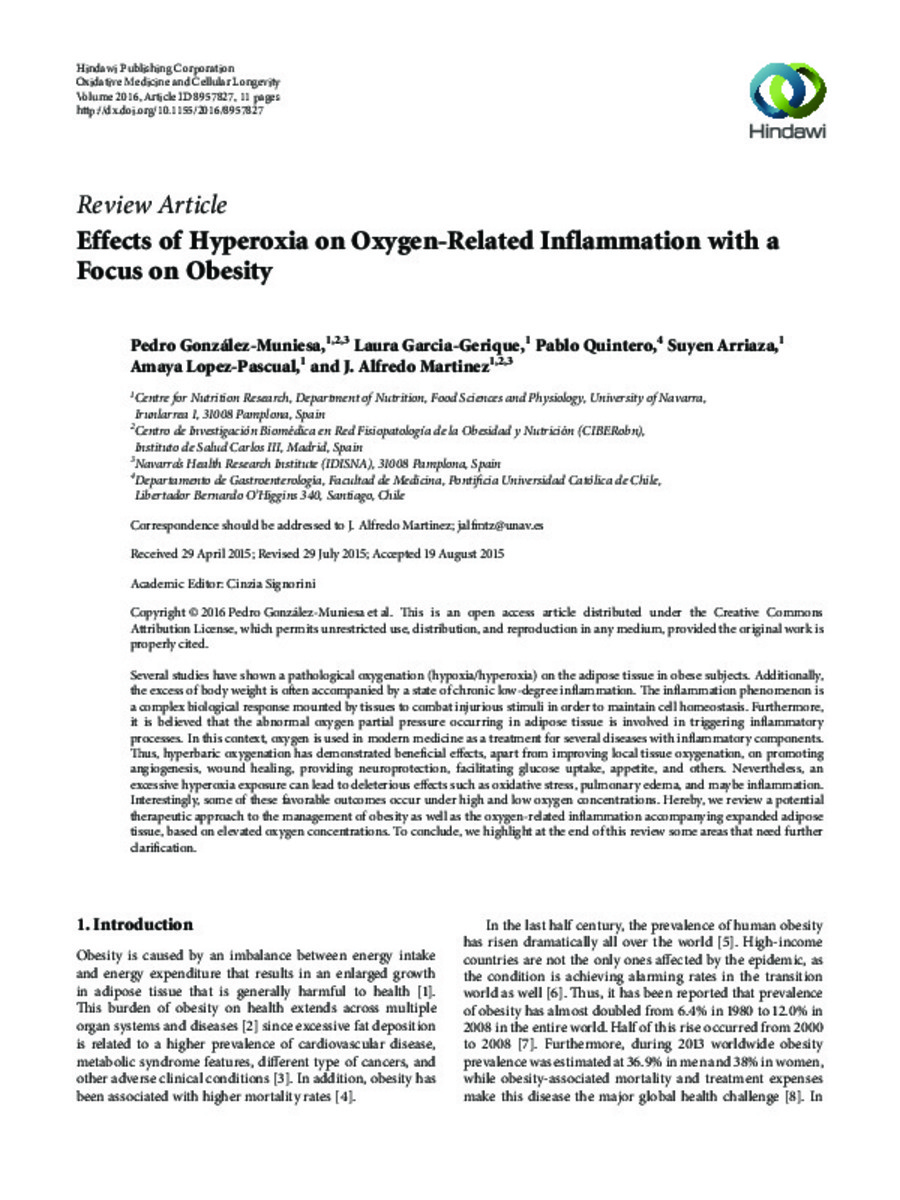Full metadata record
| DC Field | Value | Language |
|---|---|---|
| dc.creator | Martinez, J.A. (José Alfredo) | - |
| dc.creator | Lopez-Pascual, A. (Amaya) | - |
| dc.creator | Arraiza, S. (Suyen) | - |
| dc.creator | Quintero, P. (Pablo) | - |
| dc.creator | Garcia-Gerique, L. (Laura) | - |
| dc.creator | Gonzalez-Muniesa, P. (Pedro) | - |
| dc.date.accessioned | 2016-02-15T19:54:15Z | - |
| dc.date.available | 2016-02-15T19:54:15Z | - |
| dc.date.issued | 2016 | - |
| dc.identifier.citation | González-Muniesa P, García-Gerique L, Quinteros P, Arraiza S, López Pascual A, Martínez JA. Effects of hyperoxia on oxygen-related inflammation with a focus on obesity. Oxid Med Cell Longev 2016;2572606. | es_ES |
| dc.identifier.issn | 1942-0900 | - |
| dc.identifier.issn | 1942-0994 | - |
| dc.identifier.uri | https://hdl.handle.net/10171/39925 | - |
| dc.description.abstract | Several studies have shown a pathological oxygenation (hypoxia/hyperoxia) on the adipose tissue in obese subjects. Additionally, the excess of body weight is often accompanied by a state of chronic low-degree inflammation.The inflammation phenomenon is a complex biological response mounted by tissues to combat injurious stimuli in order to maintain cell homeostasis. Furthermore, it is believed that the abnormal oxygen partial pressure occurring in adipose tissue is involved in triggering inflammatory processes. In this context, oxygen is used in modern medicine as a treatment for several diseases with inflammatory components. Thus, hyperbaric oxygenation has demonstrated beneficial effects, apart from improving local tissue oxygenation, on promoting angiogenesis, wound healing, providing neuroprotection, facilitating glucose uptake, appetite, and others. Nevertheless, an excessive hyperoxia exposure can lead to deleterious effects such as oxidative stress, pulmonary edema, and maybe inflammation. Interestingly, some of these favorable outcomes occur under high and low oxygen concentrations. Hereby, we review a potential therapeutic approach to the management of obesity as well as the oxygen-related inflammation accompanying expanded adipose tissue, based on elevated oxygen concentrations. To conclude, we highlight at the end of this review some areas that need further clarification. | es_ES |
| dc.language.iso | eng | es_ES |
| dc.publisher | Hidawi Publishing Corporation | es_ES |
| dc.rights | info:eu-repo/semantics/openAccess | es_ES |
| dc.subject | Materias Investigacion::Ciencias de la Salud::Nutrición y dietética | es_ES |
| dc.subject | Obesity | es_ES |
| dc.subject | Oxygen-related inflammation | es_ES |
| dc.subject | Hyperoxia | es_ES |
| dc.title | Effects of hyperoxia on oxygen-related inflammation with a focus on obesity | es_ES |
| dc.type | info:eu-repo/semantics/article | es_ES |
| dc.description.note | Copyright © 2016 Pedro González-Muniesa et al. This is an open access article distributed under the Creative Commons Attribution License, which permits unrestricted use, distribution, and reproduction in any medium, provided the original work is properly cited. | es_ES |
| dc.identifier.doi | http://dx.doi.org/10.1155/2016/8957827 | es_ES |
Files in This Item:
Statistics and impact
Items in Dadun are protected by copyright, with all rights reserved, unless otherwise indicated.






